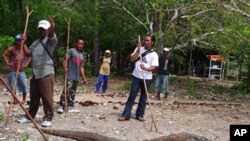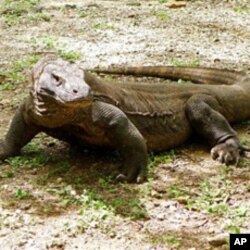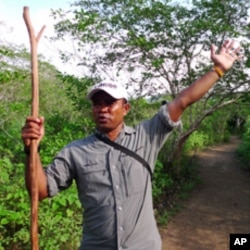Indonesia is promoting the Komodo dragon as a tourism draw, hoping the rare creatures will bring new income and attention to the Komodo National Park where they run wild.
As a gentle breeze rustles tree leaves on Komodo Island, tourists talk in whispers and snap pictures of one of the world’s largest lizards. The three-meter-long, 90-kilogram creature lumbers toward the beach while park rangers stand guard with long sticks to ensure it does not turn on a visitor.
Komodo National Park is home to around 2,500 Komodo dragons. Comprising four small islands in eastern Indonesia, the park is the only place where visitors can see today’s modern dinosaurs in the wild.
That makes it potentially a prime tourist destination. But because the park is not as well known as the Indonesian island of Bali, and because the Komodo islands are difficult to get to, tourist numbers have been below expectations.
Of the 7 million foreign tourists who visited Indonesia in 2010, most went to Bali. Only around 45,000 made the trek to Komodo National Park. This year the Ministry of Tourism expects that figure to grow by 20 percent.
The reason for their optimism is that the park was recently listed among the 28 finalists for the world’s new seven natural wonders. People vote for their favorite candidate by global poll, with the winners announced in November.
Among the other finalists are Australia’s Great Barrier Reef, Vietnam’s Halong Bay, and the Galapagos Islands.
Komodo National Park is already recognized by the U.N. Educational, Scientific and Cultural Organization as a world heritage site, but officials say being among the seven wonders would draw more attention to Indonesia and more money to the thousands of villagers living in the park.
Esthy Reko Astuty is the director of promotions at the Tourism Ministry.
"It will make that destination more popular, and it will invite more tourists to come to Komodo National Park," says Astuty. "Of course it will also impact the local people since the tourists will not only come to the destination, they will also spend their money for the accommodation and also for the merchandise or souvenir."
Komodo dragons can swim and climb trees and rely on the element of surprise when hunting. They have small but lethal teeth, capable of crunching bones, hooves and hides. They eat almost all of their victims, which include other Komodo dragons. Their acute sense of smell leads them to prey, which they inject with venom that kills slowly.
To stay safe, rangers warn visitors against separating from the group, making too much noise and getting too close to lounging lizards. "Don’t run, don’t run. She’s a female, an aggressive female," warns one ranger.
They also tell cautionary tales about tourists who have not obeyed instructions. In 1974 a Swiss man disappeared and only his camera bag was found.
Increased publicity alone may not be enough to significantly increase tourism in the country, however. For years Indonesia has failed to draw as many tourists as neighboring Thailand and Malaysia because it lacks vital infrastructure, such as hotels and efficient transportation.
Officials recognize the constraints, but they believe Komodo’s white beaches and array of indigenous wildlife make it ripe for more visitors.
But, as in other developing countries with rich natural environments, the government must balance economic need with efforts to protect the fragile Komodo environment.
Andi Kefi, who manages the ecosystem at Komodo National Park, worries that the park is a conservation area where there is already an established community. If the community continues to grow, he says, the Komodo habitat will be damaged.
He hopes the regional government works quickly to improve infrastructure in Labuan Bajo, the city closest to Komodo, and provide support to the rangers and forestry police who enforce rules against disturbing the dragons.
The national park system has partnered with the San Diego Zoo in the United States on a Komodo Survivor Program, which tracks and monitors the lizards and takes a hands-off approach to preserving their natural habitat.
All the Komodo dragons receive an ID tag in their right thigh, which records their weight and size. Rangers periodically trap the lizards and compare the data to records to better understand how the dragons are faring.
Kefi is concerned that food shortages could lead to competition between the lizards and the humans who rely on the park’s deer and buffalo. But villagers on the main islands of Komodo and Rinca say they have learned to live in peace with the lizards, thanks in part to a legend about a dragon princess, which has fostered respect for the creatures.
They also have found ways to earn money by selling Komodo dragon woodcarvings and souvenirs to tourists.
Fisherman Ali Mudar says he sees how the people could benefit from more tourism. During the next 10 years, if new people come to the island, there will continue to be progress, he says.
But for now, he will keep selling fish - always keeping a watchful eye for a Komodo dragon lurking in the distance.












